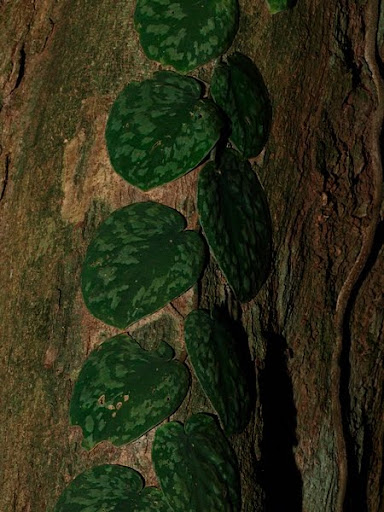 As they wave their flags and stake their claim, a true tree-hugger shy from the glare and fame.
As they wave their flags and stake their claim, a true tree-hugger shy from the glare and fame.
....rediscovering the pleasure of knowing a friend, a single-minded environmentalist who had forgone much to go about his chosen path, whose low-key hands-on attitude in rescuing plants and critters from harms' way and whose motivation appears to be solely the welfare of those under his care rather than the limelight on him .... he is my motivation to be good for the new year.
Green Crested lizard, Bronchocela cristatella
Friday, December 31, 2010
Just go easy being green
Monday, December 27, 2010
Portrait of a stinko
 First described by Lindley in 1855, Bulbophyllum lasianthum is a large orchid from Malaysia, Borneo and Sumatra with long stiff purplish leaves up to 50cm long. Like many fly pollinated plants, especially Typhonium and Amorphophallus, this orchid adopt a similar strategy to draw pollinators - the flowers look and smell like hairy rotting carcasses.
First described by Lindley in 1855, Bulbophyllum lasianthum is a large orchid from Malaysia, Borneo and Sumatra with long stiff purplish leaves up to 50cm long. Like many fly pollinated plants, especially Typhonium and Amorphophallus, this orchid adopt a similar strategy to draw pollinators - the flowers look and smell like hairy rotting carcasses.
In the lowland, the flowers open partially and only for a short period, about 2 days or so ; I had misjudged the timing on several occasions before I finally manage to capture this fresh bloom. Arriving before the flies did, I was incessantly bombarded by waves after waves of olfactory tsunamis as I worked on the closeups. 
 I had only seen it in the wild once, scrambling around wet rocks beside a stream in the lowland, occasionally curling around larger tree trunks but did not appear to climb too high. Although not a rare plant, it is not very commonly encountered.
I had only seen it in the wild once, scrambling around wet rocks beside a stream in the lowland, occasionally curling around larger tree trunks but did not appear to climb too high. Although not a rare plant, it is not very commonly encountered.
There's nothing much going for it - unwieldy size, untidy habits, partially opening hairy flowers and repelling odour - so its not very commonly cultivated by orchid growers, except those who have a fetish for the obnoxious .... yes, my kind .... Wishing all a joyous, glorious, odorous New Year !
Wishing all a joyous, glorious, odorous New Year !
Monday, December 20, 2010
Uvaria grandiflora


Saturday, December 18, 2010
Unknown Gesneriad
Found this stunning Gesneriad growing on a sandstone mountain slope in southern Sarawak.

 I have absolutely no idea what it is - if I have to make a guess it would be a Henckelia.... suggestions much welcome.
I have absolutely no idea what it is - if I have to make a guess it would be a Henckelia.... suggestions much welcome.
Thursday, December 16, 2010
Woman in chains
 ....lying and waiting is a poor man's deal
....lying and waiting is a poor man's deal
....hopelessly weighed down by your eyes of steel
It's a world gone crazy
keeps woman in chains.
- Tears for Fears -
This juvenile macaque waited patiently backstage for its Thai master to guide its entry into the show.
Friday, December 10, 2010
Mass flowering of Hoya diversifolia
 A common large vine found throughout SE Asia including Singapore, often draping trees near mangroves or rivers.
A common large vine found throughout SE Asia including Singapore, often draping trees near mangroves or rivers.
Sunday, December 5, 2010
Discovery of Paphiopedilum primulinum
Inspired by a psychic dream of finding a blue orchid, Mr Liem Khe Wie the intrepid orchid hunter from Indonesia, set off with some companions on a perilous adventure during which one of them was wasted by leaches and the rest had to wrestle a giant python before finding this elusive "dream-like" plant flowering on a mountain slope in a "remote Indonesian Island", which we later discovered to be Sumatra.
Alas, instead of a blue flower, it turned out to be yellow.
Few seemed to buy this tall tale published in Orchid Review in 1973. but the yellow plant is real and is actually an aberrant flava form ; the more typical forma purpurascens shown below, which contains anthrocyanin pigments and a noticeably pink pouch, was described some 26 years later. Other than the smaller flower, this species is similar to many members in sub genus cochlopetalum (most notably, I think, moquetteanum, liemianum and glaucophyllum) and differs by subtle colour variations of the bloom. As many orchid taxonomists will tell you, colour variation of the flower is insufficient for species delineation. But slipper orchids growers and experts are a passionate lot and they would have none of that. In light of this, I have to kowtowto Mark Wood who, in 1976, bravely suggested to lump all species in this section into a single taxon.
Other than the smaller flower, this species is similar to many members in sub genus cochlopetalum (most notably, I think, moquetteanum, liemianum and glaucophyllum) and differs by subtle colour variations of the bloom. As many orchid taxonomists will tell you, colour variation of the flower is insufficient for species delineation. But slipper orchids growers and experts are a passionate lot and they would have none of that. In light of this, I have to kowtowto Mark Wood who, in 1976, bravely suggested to lump all species in this section into a single taxon.
Unlike many of the Paphs, this species actually do well in the lowland and would flower quite frequently. The spike consists of several flowers which open singly and sequentially so flowering period appear to extend up to 3 months or more.
Addenda: I suspect the forma purpurascens shown in this pic to be a hybrid called Pinocchio, which is the same as the wild form except for the bigger flower.
Saturday, December 4, 2010
Life as we know it....
 Migrating grebes and ducks foraging in early light ..... my etched impression of Mono Lake in Autumn.
Migrating grebes and ducks foraging in early light ..... my etched impression of Mono Lake in Autumn.
With the surreal spires of tufa, great pool of still water and encircling misty mountains, I thought that if someone were to find an alien life form on earth, a Loch New Monster or something, it would be in a place like this.
Less than 2 months later, NASA published finding a bacteria in that lake that not only utilise Arsenic for energy but use this to replace Phosphorous in their cell structures...in DNA, cell membrane etc. Now both P and As are in the same column in the periodic table which essentially means chemically they are rather similar. However, biochemically, Arsenic, as we know from our Science if not from murder books, blocks the Krebs cycle, the ubiquitous path to energy production in aerobes, which eventually leads to cell death. Even anaerobes dispel this element from the body after utilisation. So to have it as part the of cell structure is unthinkable.
Granted, an image of a bacterium does not inspire as much awe as a Nessie but the scale of the discovery is such that basic science book will be rewritten and life as we know it is no longer limited to what it used to be.
Well, I was just glad I did not heed a guide book's proposal and took a plunge in the Arsenic broth....what happened if I accidentally took in a mouthful ?
Here's the link to Nasa's Report
Wednesday, December 1, 2010
Another Caudiciform Impatiens
This one again coming from the Indo China region, where exactly I am not sure but I was told it was from Laos (unsubstantiated). The medium size flattened bulb produce a plant with reddish stems and green leaves with a red mid-vein. The whorled arrangements of the leaves, the long racemes and its corky caudex sets it apart from the other more herbaceous Impatiens with Annual growth patterns.
The medium size flattened bulb produce a plant with reddish stems and green leaves with a red mid-vein. The whorled arrangements of the leaves, the long racemes and its corky caudex sets it apart from the other more herbaceous Impatiens with Annual growth patterns.
 While resembling an I. mirabilis, this is quite different in a few ways namely the red stems the scarlet fine roots that appear when it breaks dormancy and scalloped leaves. Also, it is seasonally dormant, dying down to the horizontally flattened tuber annually, which is quite different from a mirabilis which rarely goes dormant unless in severe drought. On top of that, this plant rot so easily in the lowland that I am pretty convinced it is a dryish highland species.
While resembling an I. mirabilis, this is quite different in a few ways namely the red stems the scarlet fine roots that appear when it breaks dormancy and scalloped leaves. Also, it is seasonally dormant, dying down to the horizontally flattened tuber annually, which is quite different from a mirabilis which rarely goes dormant unless in severe drought. On top of that, this plant rot so easily in the lowland that I am pretty convinced it is a dryish highland species.
Anyway there appear to be a few new species of caudex-type Impatiens unleashed from this region in recent years, mostly from the limestone hills.... so while we wait for the experts to publish their authoritative findings, I welcome any reports of other fellow grower's experience and observations on this interesting group of plants.
Friday, November 26, 2010
Dendrobium garrettii
 The minuscule bloom of this Thai orchid revealed .....each flower is less than 1cm long. The plant goes dormant seasonally, leaving only small spindle shaped pseudobulbs smaller than fingernails pronouncing its existance.
The minuscule bloom of this Thai orchid revealed .....each flower is less than 1cm long. The plant goes dormant seasonally, leaving only small spindle shaped pseudobulbs smaller than fingernails pronouncing its existance.
Tuesday, November 23, 2010
Hairy Pottery and the deathly hole
I am getting an unbearable amount of spam comments on this subject for some time now, (mostly asking me to see some free streaming) .... so here's my version of this episode.... presenting....
Hairy Pottery and the Deathly Hole ......
"Oh no....those black flying tattered cloaks are here again....I am so mortified I cannot recall its name...let's hide....hmmm these are convenient ....."
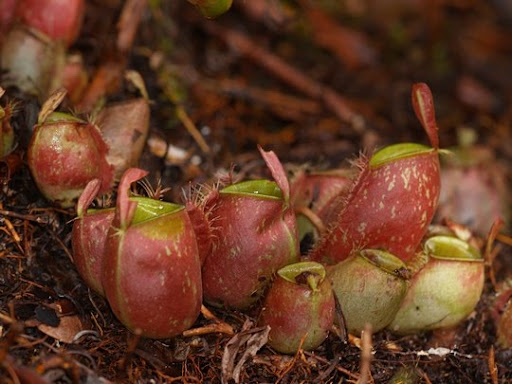 "...oh...shall we hide in the bigger one ? It'll give us more head room .... "
"...oh...shall we hide in the bigger one ? It'll give us more head room .... "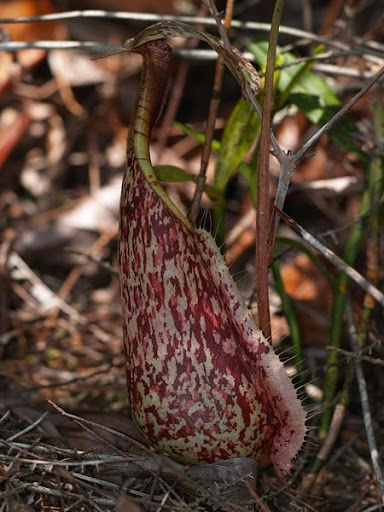 ........"Arghh ! " .........
........"Arghh ! " .........Dear Reader, our three young heroes are kindhearted and quick-witted, but their lives, I am sorry to say, are filled with miseries and series after series of unfortunate events. Hence, despite being named after Nepenthe Pharmakon...the drug that chase away sorrows, this so mentioned pottery is the mother of all sorrows...especially if you are a bug, as our heroes are. So, if you have a stomach for deception, contraption, acidification, dissolution, obliteration and assimilation do stick around and proceed to.....
Hairy Pottery and the deathly hole Part II
Our villians of the day: (top) Nepenthes ampullaria, a deliciously pink form and (bottom) Nepenthes rafflesiana, a tricolored form from Sarawak.
Thursday, October 14, 2010
At a Coastal forest
Yet the next day, I returned, with a companion and an umbrella - just in case. I had to get through this mangrove to reach a jungle path behind it and my curiosity was getting the better of me.
Almost immediately, we were met by this critter, which appeared to be a form of plantain squirrel that is larger and more bushy-tailed than its southern cousin......
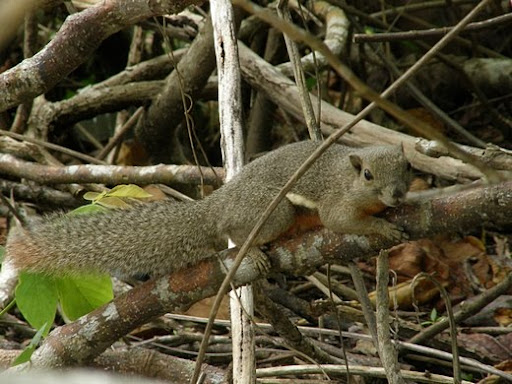 .... our attention soon turned to the water to find some darting mud skippers - a melancholic looking goby which can breath air....in fact it has been kown to drown in aquariums tanks which have too much water.
.... our attention soon turned to the water to find some darting mud skippers - a melancholic looking goby which can breath air....in fact it has been kown to drown in aquariums tanks which have too much water. 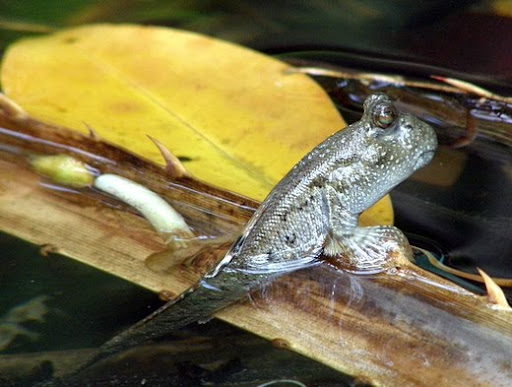 .... the large orchid Cymbidium finlaysonii is everywhere near the clearings, even growing on the sandy ground.
.... the large orchid Cymbidium finlaysonii is everywhere near the clearings, even growing on the sandy ground. As we ventured further inland, we entered a lowland dipterocarp forest which turned out to be an orchid paradise. I was surprise to see this Dendrobium aloifolium growing in clumps on boulders so near the ground level - I had previously only seen them on fallen logs - usually they are perched high on the inaccessible parts of the trees. This plant had very interesting succulent leaves but its flowers - borned on the long terminal spikes, were minute and unattractive.
As we ventured further inland, we entered a lowland dipterocarp forest which turned out to be an orchid paradise. I was surprise to see this Dendrobium aloifolium growing in clumps on boulders so near the ground level - I had previously only seen them on fallen logs - usually they are perched high on the inaccessible parts of the trees. This plant had very interesting succulent leaves but its flowers - borned on the long terminal spikes, were minute and unattractive.
 Bulbophyllums seemingly from section Sestochilus were all over the place - this one dangling above the water was pregnant. It appeared that I had just missed the flowering season as none of them were blooming .....
Bulbophyllums seemingly from section Sestochilus were all over the place - this one dangling above the water was pregnant. It appeared that I had just missed the flowering season as none of them were blooming .....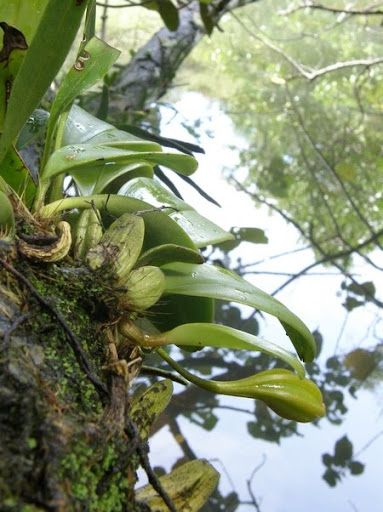 .... another orchid that looked also like a Bulbophyllm but was in fact Thelasis pygmaea.
.... another orchid that looked also like a Bulbophyllm but was in fact Thelasis pygmaea.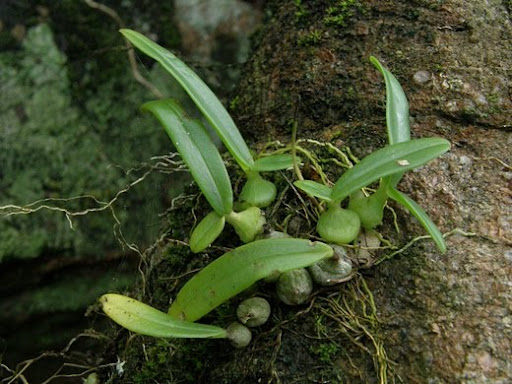 Draping the branches and rocks are these Dischidia bengalensis .... a common and widespread Asclepiad that lived in close association with ants.
Draping the branches and rocks are these Dischidia bengalensis .... a common and widespread Asclepiad that lived in close association with ants. .... just above our heads are these Hydnophytum formicarum - a curious member of the Rubiaceae family that had hollow chambered stem sheltering ants and many other creepy crawlies - this particular one had a 10cm long centipede curled within. These tenants paid their dues by providing protection and whatever crap and leftovers to nourish the plant.
.... just above our heads are these Hydnophytum formicarum - a curious member of the Rubiaceae family that had hollow chambered stem sheltering ants and many other creepy crawlies - this particular one had a 10cm long centipede curled within. These tenants paid their dues by providing protection and whatever crap and leftovers to nourish the plant. On higher ground and crossing a stream, green and red forms of Nepenthes mirabilis were growing on the soggy banks.
On higher ground and crossing a stream, green and red forms of Nepenthes mirabilis were growing on the soggy banks.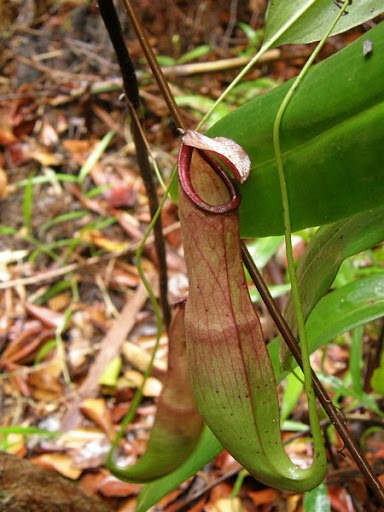
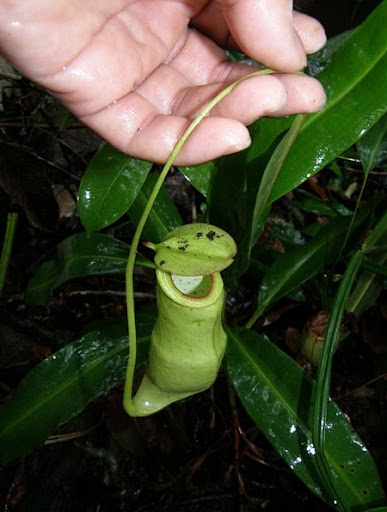 Some Dipterocarps had left their winged fruits on the ground ; these would make an interesting potpourri - all I need is a few drops of fragrant oil !
Some Dipterocarps had left their winged fruits on the ground ; these would make an interesting potpourri - all I need is a few drops of fragrant oil !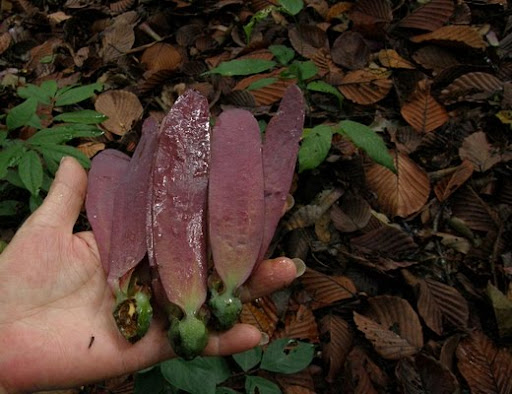 As we walked pass this straggler vine and its host, we were reminded once again that even in the seemingly docile plant world, the savage struggle for resources was unrelenting .....
As we walked pass this straggler vine and its host, we were reminded once again that even in the seemingly docile plant world, the savage struggle for resources was unrelenting .....  Bad luck for the tree ....its fate was sealed. The straggler constricted and cut through its bark, impeding the flow of water and food, and the tree suffered a slow demise. After it eventually rotted away, only a giant spring-like liana will remain, with one less competitor for sunlight.
Bad luck for the tree ....its fate was sealed. The straggler constricted and cut through its bark, impeding the flow of water and food, and the tree suffered a slow demise. After it eventually rotted away, only a giant spring-like liana will remain, with one less competitor for sunlight.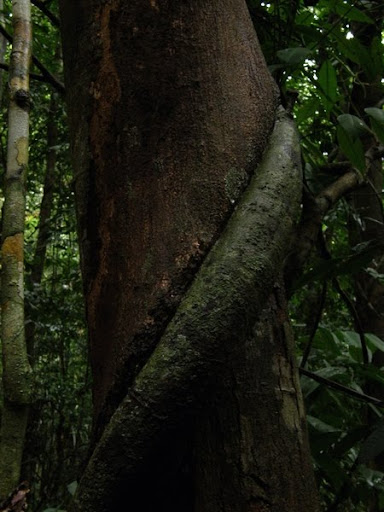 Trees along the trail were not really very big - this was one of the bigger one, and came equipped with a useful little hollow.
Trees along the trail were not really very big - this was one of the bigger one, and came equipped with a useful little hollow. 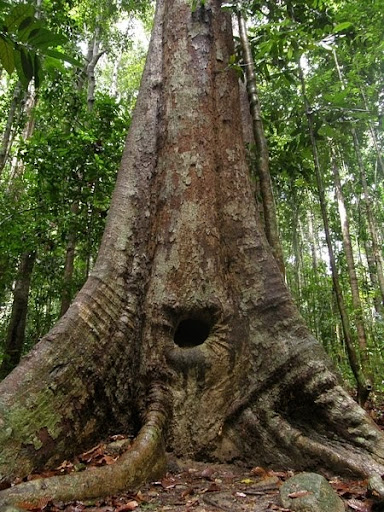 The monkeys did not show up this time but the rain did, so we had use for the umbrella afterall. We kept our heads and noses dry....more or less.
The monkeys did not show up this time but the rain did, so we had use for the umbrella afterall. We kept our heads and noses dry....more or less. Sunday, October 3, 2010
Spathicarpa hastifolia

 The Drosophila are having a splashing good time fooling around on the spathe....or spadix of this aroid. In this South American plant, the spathe and spadix are fused - so it appears that the flowers are borned straight on a leaf.
The Drosophila are having a splashing good time fooling around on the spathe....or spadix of this aroid. In this South American plant, the spathe and spadix are fused - so it appears that the flowers are borned straight on a leaf.
Actually, the true leaf is more heart shaped - which is how it got its latin name.
There are a handful of species of Spathicarpa confined to sub-tropical/tropical S. America and all have the a habit of going seasonally dormant. This species is related to the more commonly cultivated caterpillar plant Spathicarpa sagittifolia.
Wednesday, September 29, 2010
Extinction threat to one fifth of world's plants
Saw this grim heading from AFP citing recent studies from Kew.
Stephen Hopper, director of the Royal Botanic Gardens in Kew was quoted as saying "This study confirms what we already suspected, that plants are under threat and the main cause is human-induced habitat loss"
....well , not new, but perhaps now they can put a number to it ....
Especially threatened is the habitat of tropical forest, which has been converted to agricultural land. Human activity accounted for 81 percent of threats, according to Kew researcher Neil Brummitt.
Here's another snippet :
Plants were more threatened than birds, as threatened as mammals and less threatened than amphibians or corals, it said. Gymnosperms, the plant group including fir trees, were the most threatened.
Well....ok....so what can we do about it ?
Rather then just leaving it to a handful of institutions, I suppose if each serious gardener can adopt just one or two species - propagate them well and send them off to interested parties all over the world, then this could lighten the load. But unfortunately, things are not so simple - even if there are gardeners with inclination and expertise, we still have to overcome regional politics, CITES, customs and security red tapes and the like ....
....enough muttering, back to the garden.
You can see full reports all over the web, but here's one from yahoo
Addenda:
In response to rohrerbot's comment, I did a rough calculation - we can actually pack everyone in the world into a land mass the size of Sweden if we can accept living conditions equivalent to people from the Korean capital of Seoul (hey, I am not talking about Mumbai here), and leave the rest of our planet to the wildlife and plants. Its a rough guide but it just goes to show how much can be improved upon if there is a will.
Basis of my calculations :
world population of 6871600000
Population density of Seoul 167000
Sweden land mass 450 000 sq/km
Sunday, September 26, 2010
Unusual resurrection plant
This interesting Gesneriad was found growing on bare limestone hills of S Thailand. You can see that in nature, the dead leaves are left wrapped at the base of the plant. On several occasions when I failed to water the plant, the leaves withered totally to the brown colour of the dried leaves seen above. Upon dunking it in water several times, the plant miraculously revived - with the same brown leaves turning green once more.
On several occasions when I failed to water the plant, the leaves withered totally to the brown colour of the dried leaves seen above. Upon dunking it in water several times, the plant miraculously revived - with the same brown leaves turning green once more.  The plant produced multiple branching inflorescence once or twice a year
The plant produced multiple branching inflorescence once or twice a year the bloom appeared to be typically Paraboea but it has yet to set seed naturally so far, which would verify its standing.
the bloom appeared to be typically Paraboea but it has yet to set seed naturally so far, which would verify its standing.
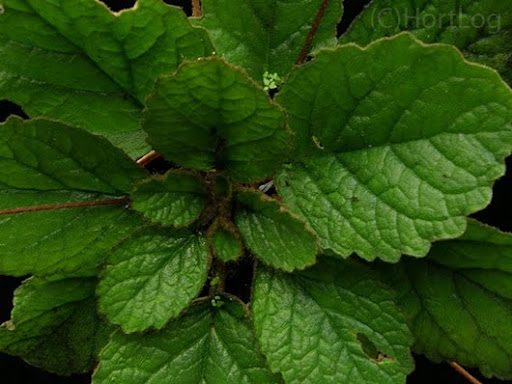 The leaves are hirsute on both sides, with brown hairs at the leaf edges, venations and petioles.
The leaves are hirsute on both sides, with brown hairs at the leaf edges, venations and petioles.
I am guessing its some kind of Paraboea but its specific name remain to be identified. Any suggestions are much welcome.
Saturday, September 11, 2010
Colugo revisited
Probably sensing I was not having the best of luck, afterall its a dark drizzly afternnoon in Bukit Timah Hill, a jogger came over and asked if I would be keen to shoot a colugo. Without waiting for my answer, he pointed to a tall tree about 20 metres away where about 10 metres or so above the ground was the silhouette of a suspicious looking lump.
Quietly, I moved closer, took aim, held my breath and fired away ....


 This one kept to its daytime posture of trying to look like a cancerous outgrowth from the tree. I made funny sounds to try to make it turn its head towards me so that I could get a decent portrait to shows its friends but it just would not budge.... but you can see some flaps of skin under its armpit if you look hard enough.
This one kept to its daytime posture of trying to look like a cancerous outgrowth from the tree. I made funny sounds to try to make it turn its head towards me so that I could get a decent portrait to shows its friends but it just would not budge.... but you can see some flaps of skin under its armpit if you look hard enough.
Anyway, its a nice feeling, like seeing an old friend.
See also my nightime encouter a few months back.
Friday, September 10, 2010
Juvenile crawler

